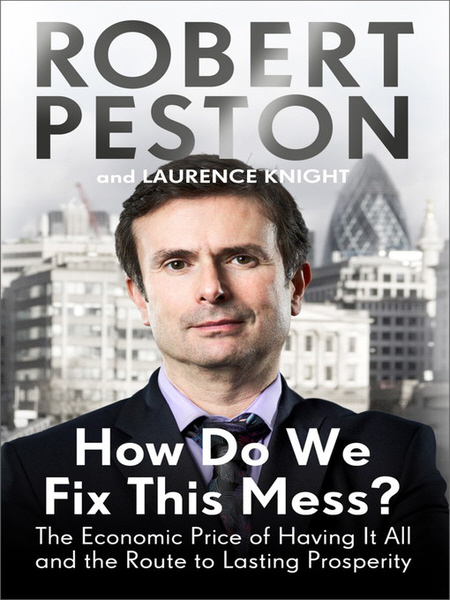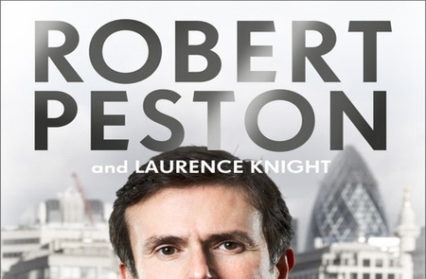Adam Somerset casts a critical eye on How do we fix this mess? by television reporters Robert Peston and Lawrence Knight.
The authors of good books do not necessarily make for good television reporters and the converse is also true. Robert Peston and Lawrence Knight’s How Do We Fix This Mess? reads like an extended television bulletin. The prose is fast and fluent, personal encounters with the great and the good are regular, it offers condensed summaries of many topics. It is also plumped out with extraneous detail and generality. Its range of voices is limited, chunks are not much more than ‘churnalism’, the last chapter is a galloping rehash of news headlines of the time the book went to press. It comes without notes or bibliography; rightly, as there is no evidence of reading or original research.
The acknowledgements make no mention of an editor. Maybe Hodder and Stoughton did not worry about providing one. The book has two authors. The face of only one appears on the dust jacket and his biography on the inside cover is four times the size of the second. Joint authorship can work brilliantly, as when Desmond and Moore took on Charles Darwin. Here, it looks as though the role of the subsidiary author has been to fatten the text with cut-and-paste material. As a result How Do We Fix This Mess? lacks that stamp of genuine authorial conviction. Its somewhat anonymous voice tilts more to enthusiasm than critical enquiry. In genre it nudges closer to celebrity memoir than a study fuelled by insight and passion.
The prime weaknesses of How Do We Fix This Mess? are threefold, and reinforce each other. The most obvious is the tiny span of voices. The authors meet very few people. Those who do feature are exclusively men at the top, characterised by a tone of matiness rather than intellectual critique; ‘the late Sir Brian Pitman, the long-serving chief executive of Lloyds, once told me’… ‘this is how one of China’s new billionaires…put it to me’…‘as the former fund manager David Pitt-Watson once said to me’… ‘in the summer of 2011 I did ask the Chinese Premier, Wen Jiabao’…’ led to a lunch with the chief executive’… ‘Hector Sants disclosed to me.’

by Robert Peston and Lawrence Knight
The relationship with these men of power nudges towards the clubby. When the venerable Cable and Wireless Worldwide was put into play in 2012 it came with five point two billion pounds of tax losses. The authors repeat, without comment, an assurance by a purchaser that these will not be deployed, in Britain at least. But surely directors and auditors are not permitted to simply write out historic tax losses.
The writers are impressed in China: ‘the senior ministers I’ve met…the commerce minister and prime minister…exude charm and culture, and have responded to my questions perhaps less mechanistically than has been typical of many British ministers in recent years’. That country’s smog-spluttering subjects, who attempt to blog about how terribly well so many ministerial family members are doing in the new China, might be rather less fulsome on their rulers’ charm and culture.
But the view from the boardroom is the wrong approach, for a reason that is obvious. Boards failed, for a range of reasons, to discharge their duties. The reader wants to know why. A journalist who works, like Gillian Tett, may do lunch in the executive dining room, but she digs ago. If a writer wants to know about banking, she hangs out after hours in Canary Wharf bars. All those ruinous CDO’s were not abstractions. Applicants lied, salesmen fabricated bank statements, somewhere managers in the hierarchy stamped their approval on it. Horse was turned to beef, and a writer goes after it.
Each financial Goliath devised different techniques for running round their own risk staff. One trick would be to keep secret a proposal that had required weeks of work until a couple of hours before the meeting to approve it. The risk team would then have no time to lodge convincing objections. Special investment vehicles (SIV’s) were devised solely in order to bust the rules. According to a senior consultant one risk manager was just instructed ‘you tick the boxes on risk, and we’ll worry about generating revenue’. An accounting practice known as Repo 105 in the US allowed firms to flatter their numbers by temporarily moving assets off their balance-sheets at the end of each quarter. Special Investment Vehicles, risk and risk managers, auditors and auditing even, are all absent from this book’s index.
It is a book about debt that omits mention of the Private Finance Initiative. PFI projects are thin on the ground in Wales. It would be nice to think that Welsh leaders take a more bracing view of loading our children with the bill. It is true that Britain does have a lot of noughties new building to show, and a lot left to be paid for. The Brownian legacy for PFI, although there is not a whisper of it here, is £267,000,000,000.
The lack of voices gives the book a tone of blandness and generality. When they come to Greece, it is strictly cut-and-paste. The authors do not give an impression that they get Greece at all. The nub of it is that Greece – a bit of yoghurt and olive oil apart – was barely connected to the European market. A writer tells the reader why. A proper reporter, like Michael Lewis, provides the right richness of detail. A civil service job in Germany that was graded at fifty-five thousand Euros a year was graded at seventy thousand Euros in Greece.
Inflation worries? When the price of an item rose – tomatoes for instance – Greece’s government statisticians niftily removed it from the index. Charlemagne, an anonymous reporter for the Economist, is not just more intellectually engaged with Greece, and swingeing in his critique and remedy, but actually more sympathetic to the country’s people.
The financial crisis of 2008 was big, but it was not unique. The Nordic countries suffered their own in the 1990’s. Out of it they refashioned a new state-private sector relationship and admirable welfare states. If they maybe have a lesson for us, the authors here are not going to tell us. ‘The 1990’s crisis in Scandinavia forced the government directly to organise a reconstruction of the country’s banking system… both Sweden and Finland returned to fairly robust growth in a matter of a few years, on the back of specific phases of recovery.’ This must be some of the dullest journalist prose ever.
The point about capitalism is that it worked for two generations. It is not just that the average working Briton acquired a washing machine, Mediterranean holiday and a lifespan of eighty years plus. The real triumph is that three billion people worldwide were raised from lives of subsistence poverty. The authors can do headlines but there is small evidence that they really know capitalism. The credit rating agencies get their turn but no mention of the ambiguous role they played. The Department of Justice filed a criminality suit this month against Standard and Poor. No writer can be expected to tell the future, but they could take the trouble to explain the Raters’ funding structure.
How do we fix this mess? has a Panglossian smile at the free-wheeling ease of movement of high-skilled labour. It is not really the picture at all. It might have helped if someone had picked up a phone and just talked to an HR manager, for instance, in the software industry.
They do not really give much impression of knowing the banks well. Legally these sprawling conglomerates were public companies, but some divisions within them operated as de facto employee co-operatives. Being smart people the staff did not take paper. Terms of employment were strictly cash. It is only H M Government, and by extension every Briton who expects something of their local school and hospital, who is stuck with a dud, mark-to-market-valued, illiquid asset.
Peston and Knight do not know market structure. ‘There seems to be something about the size and structure of the British economy that gives sustenance to a quintet of four or five very large banks’ is twaddle. All mature markets tend to oligopoly, in which four or five players hold a combined eighty to ninety percent share. A section ‘Globalisation and Innovation’ reprints a few medical cuttings and is truly Panglossian. The benefits of gene-based personalised medicine are still remote. Humanity has little in its pharmaceutical cupboard to slow the epidemics of depression and diabetes. Our grandchildren are going to go back a century and die of simple pneumonias.
In this simplified view of the word corporate ownership in this world is declared as ‘the profits and dividends of the Vodafones and Unilevers are our profits and dividends.’ Try telling that to the policy-holders at Equitable Life. A lot of City folk stand between the average worker and his hard-earned tiddly pension pot. Equitable Life too goes without mention.
It is hard to know whom this book is for. For the reader wanting to know about Ricardo and competitive advantage, or the Basel Rules, or the history of the Eurozone the articles on Wikipedia are fuller, faster and free-er. The prose contains a measure of grandstanding: ‘I speak to insightful and brilliant people every day. And the way I tend to work is to bounce ideas off them and see what comes back.’ It is a surprise then to read, ‘It was not until 4 March 2009 that I understood the power and meaning of globalisation’. That is a remarkable full sixteen years after its popularisation by a business writer. The seven pages on Northern Rock – Wikipedia again is livelier and more rounded – feature the words ‘I’ and ‘me’ twenty-two times; the name of Chancellor of the Exchequer, Alastair Darling, not at all.
What is so frustrating is the sheer lack of journalistic colour. Many of these alpha male bankers are terrific characters. They beg for a writer to catch them. At Britain’s largest lender, the dear old Halifax, a Saturday morning salesmen who had hit target got cash, those who were below were given a cabbage. Whether this kind of ritualised humiliation is good for corporate governance goes unasked. The man from ASDA was in charge. One wonders if he approved, or even knew.
A number of other books on the crisis deserve reading before this one. For the political view read Alastair Darling’s Back from the Brink. For the view from the once-insider read Michael Lewis on The Big Short and Boomerang. Justin Cartwright delivers a robustly comic fictional angle in Other People’s Money. To grasp the maths, and its misuse, read Gillian Tett Fool’s Gold. This book’s authors pass on Black-Scholes and the Value at Risk model. Gillian Tett has one considerable advantage, apart from the fact that she has done some work: she trained as an anthropologist. Finance, to paraphrase Clemenceau, is too important to be left to the financiers.
The title takes the form of a question. The subtitle reads ‘The Economic Price of Having It All and the Route to Lasting Prosperity.’ The answer is ‘The priority for us is to rebuild our economy on firmer foundations, so that we are less vulnerable next time’. So there it is, after four hundred and sixty-nine pages. The commissioning, sales, indeed my reading, of How do we fix this mess? are wholly due to the nature of the writers’ corporate employment. The authors of good books do not necessarily make for good television reporters and the converse is also true.
How do we fix this mess? by Robert Peston and Lawrence Knight is available from Hodder and Stoughton.
Adam Somerset is an essayist and a regular contributor to Wales Arts Review.











